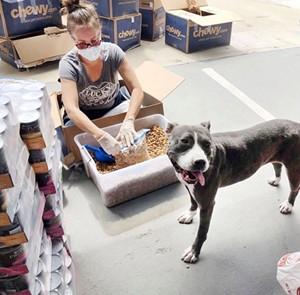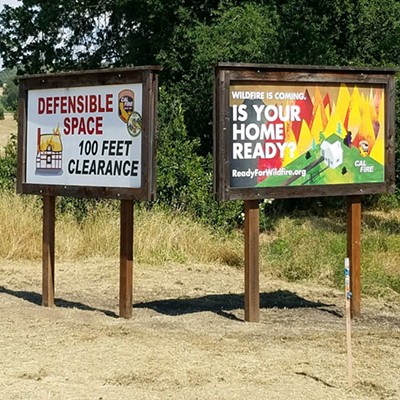Bob, a Santa Maria local, is a longtime dog owner. He used to own three dogs but now owns just one, a rambunctious Australian shepherd mix who loves to run, he told the Sun.
Instead of going to the pet supply store to buy food for his dog, Bob (who asked the Sun not to use his last name) goes to the Santa Barbara County Animal Services’ Santa Maria pet resource center, where he can pick up dog food for free. He said having this option has greatly benefited him.

“I’m a senior citizen, and that’s another bill that I don’t need to pay for my dogs,” Bob said.
The Santa Maria Pet Resource Center that Bob benefits from is one of three that Santa Barbara County Animal Services runs in collaboration with local pet organization partners. The Santa Maria center was launched in January 2020 in partnership with CARE4Paws, a nonprofit working to keep pets out of shelters. It was “a super success,” county Responsible Pet Ownership Program Coordinator Jessica Ortega-Wiebe said, and it was clear that other local communities would benefit from having a similar resource. In late May, two more pet resource centers opened in Lompoc and Goleta.
The centers are part of a larger shift within county Animal Services toward what the pet sheltering industry calls “community-based sheltering.” The goal is to provide community members with the resources they need to keep their animals in their homes, rather than being forced to surrender them to a shelter.
Pet owners can pick up free dog and cat food and other supplies at the resource centers as well as sign up for pet medical services at either a CARE4Paws mobile clinic or the Santa Barbara County Animal Services clinic.
This resource is particularly important for Lompoc. In November 2020, the county announced that it would no longer be sheltering animals at its Lompoc facility.
But county Animal Services wants to ensure that Lompoc pet owners can still access resources they might need. While the Lompoc shelter no longer houses animals, it’s now the new pet resource center where people can pick up pet food and sign up for low-cost veterinary services. Companion Animal Placement Assistance (CAPA), a volunteer-run nonprofit, is the leading agency operating the Lompoc resource center.
In addition, CARE4Paws and Animal Services reach the Lompoc community with pet services on Tuesdays and Fridays, and run a mobile clinic every first Sunday of the month at Ryon Park.
“We’re working hard together to provide as much support in the community as we possibly can so that the community members don’t feel like they’re that impacted by the shelter being closed,” CARE4Paws Executive Director Isabelle Gullo said. “If they would normally go to the Lompoc shelter to get assistance with something, they can come to a CARE4Paws event that we’re doing with Animal Services.”
Ortega-Wiebe said this collaboration is part of a larger shift in the vision and mission of sheltering: measuring success by how many pets stay with families, rather than how many animals end up in the shelter.
“We don’t want anyone to give up their pets, so if they need food then we have it,” she said. “If they need leashes and beds, we have it. We have low-cost medical care now, we have spay-neuter resources.”
Angela Walters Yates, director of Santa Barbara County Animal Services, said the pandemic provided an opportunity to step back and find the root causes of animals ending up in shelters in Santa Barbara County.
“It’s a win-win: There’s a cost to our taxpayers in the county when animals come into the shelter system, and if we can provide a little food or support or supplies during a turbulent or insecure time for people, that allows them to keep their pets with them, that’s a huge win for the community,” Walters Yates said. “And we’re seeing the benefits of it—we are really seeing a lot of those adoptable, social, family animals staying put in their homes and not coming into the shelter.”
Ortega-Wiebe said people who come in to surrender their pets often say it’s because they can’t afford their pet’s medical bills.
“We don’t want people to have to choose between paying bills and feeding their animals,” she said. “That’s why we’re here, and that’s why community-based sheltering is bringing those resources into the communities.”
Animal Services recently won a grant from Maddie’s Fund—a national foundation that awards money to pet shelters and foster care organizations—for the work that the county’s animal control officers have done to embrace community-based sheltering.
“The grant money will go back into these services, and we specifically are earmarking it for the outreach services,” Ortega-Wiebe said.
Another aspect of community-based sheltering is the movement toward a less punitive approach from entities like county animal control.
Before, “our officers were always more like, ‘Do you have a license?’ And if you don’t, ‘Let’s give you a ticket,’” Ortega-Wiebe said. “And now it’s like, ‘You don’t have a license? Well, here, let me help you get it. I can sell you one.’ … It’s about offering them all the resources right then and there on the spot, versus sending them back to the shelter or just being a heavier hand, as the traditional animal control used to be.”
This is especially important in North County communities that have more barriers to access.
“The lack of technology and resources that people don’t have are demographic here, especially in the North County,” Ortega-Wiebe said. “There’s a big portion of them that don’t have access to internet, they don’t have cellphones. So part of that community-based sheltering is how can we help those people that don’t have that, and how can we bring it to them?”
Walters Yates said that in South County, there’s a higher return-to-owner rate than in the north.
“Yesterday, in a single day, we had four or five dogs come in to the [Santa Barbara] shelter, and then within an hour their owners were at the shelter reclaiming their dogs,” she said. “In the South County, a lot of the dogs are microchipped, or they have ID tags on them. They’re very easy for us to keep out of the shelter or have their stays be very brief.”
Another key difference is that North County is physically more spread out and agricultural.
By comparison, “the South County’s concentrated, it’s a more urban environment, it’s easier to have access to services,” Walter Yates said. “In the North County, it really behooves us to take those services, like microchipping and licensing and vaccination clinics, out into the individual pockets of the community.”
Animal Services and its community partners are offering free microchipping countywide, which ensures that more pets can be reunited with their owners if they ever go missing. On June 27, the county went to Guadalupe to meet hard-to-reach pet owners where they’re at.
“The Fourth of July is coming up so we don’t want all these animals to be in the shelter if they get out because it’s scary, the noises aren’t fun,” Ortega-Wiebe said. “So we’re doing this big microchip campaign right now with our partners, and it’s free microchips countywide.”
But a question that looms for county Animal Services and its partners is: Will the positive effects of the pandemic—such as an increased interest in fostering—continue in a post-COVID world? There’s some concern that people who adopted a pandemic puppy will suddenly find themselves with less time to care for it as the world opens back up.
“We have seen an uptick in stray animal intake and owner surrenders. We have seen 11 owner surrenders since June 15, 2021, when California technically opened,” Ortega-Wiebe said. “People are adjusting to getting their lives back on track. … We are hoping that this will level out and won’t be a continued trend.”
Walters Yates added that there will always be a need for animal shelters: A 100 percent shift to community-based sheltering isn’t realistic because there will always be animals that need a safety net.
“But I think the sincere hope with this is that the days of the massive shelters that are housing hundreds of animals at a time will be a thing of the past,” Walters Yates continued. “In the animal sheltering industry, when everybody had to stay at home and COVID first hit, the first thing people did was want an animal. … The shelters across the country were cleared out, and stayed that way. We were able to open up foster homes that previously weren’t available.”
However, she added, it’s too early to tell. But the county’s new services, like the pet resource centers, won’t be going anywhere.
“Even though things are opening up, we are still going to continue that work,” Ortega-Wiebe said. “I think that’s the blessing in the pandemic: We all realized what we can and can’t do.”
Reach Staff Writer Malea Martin with story ideas or comments at [email protected].














